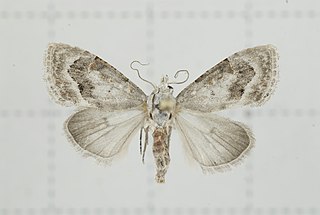Pamphlebia is a monotypic moth genus in the family Geometridae described by Warren in 1897. Its only species, Pamphlebia rubrolimbraria, was first described by Achille Guenée in 1857. It is found in Sri Lanka, Borneo, Indonesia, Taiwan and Australia.
Temnolopha is a genus of moths belonging to the subfamily Olethreutinae of the family Tortricidae.
Choreutis ophiosema is a species of moth of the family Choreutidae first described by Oswald Bertram Lower in 1896. It is found in India, Sri Lanka, China, Taiwan, Amoy, the Moluccas, eastern Australia and Japan.
Syntozyga ephippias is a tortrix moth, belonging to tribe Eucosmini of subfamily Olethreutinae. The species was first described by Edward Meyrick in 1907. It is found Sri Lanka, India, the Democratic Republic of the Congo, South Africa and Rodrigues.
Polylopha epidesma is a species of moth of the family Tortricidae first described by Oswald Bertram Lower in 1901. It is found in India, Sri Lanka and Australia.
Choreutis orthogona is a moth in the family Choreutidae. It was described by Edward Meyrick in 1886. It is found in India, Sri Lanka, Myanmar, Celebes and New Guinea.
Brachiolia egenella is a species of moth of the family Tortricidae first described by Francis Walker in 1864. It is found in Sri Lanka, India, South Africa and on the Comoros and Mauritius.
Brana is a monotypic moth genus of the family Noctuidae. Its only species, Brana calopasa, is found in Sri Lanka and Australia. Both the genus and species were described by Francis Walker, the genus in 1858 and the species in 1859. It It is a serious pest on Berrya cordifolia.
Euproctis rhoda is a moth of the family Erebidae first described by Frederic Moore in 1879. It is sometimes classified as a subspecies of Euproctis howra. It is found in India, Sri Lanka, Myanmar, the Andaman Islands and Australia.

Argyrocosma inductaria is a moth of the family Geometridae first described by Achille Guenée in 1857. It is found in Sri Lanka, India, Peninsular Malaysia and Borneo.
Chorodna strixaria is a moth of the family Geometridae first described by Achille Guenée in 1858. It is found in India, Vietnam, Sulawesi, the Philippines, the Moluccas, New Guinea, Australia and Sri Lanka.
Petelia medardaria is a moth of the family Geometridae first described by Gottlieb August Wilhelm Herrich-Schäffer in 1856. It is found in the Indian subregion, Sri Lanka, Malaysia, Borneo, Queensland and the Bismarck Islands.
Scardamia metallaria is a moth of the family Geometridae first described by Achille Guenée in 1858. It is found in Sri Lanka, India and Australia.
Thalassodes veraria, is a moth of the family Geometridae first described by Achille Guenée in 1858. It is found in Sri Lanka, Fiji, India, Java, Malaysia, New Guinea and Australia.
Dysaethria conflictaria, or Epiplema conflictaria, is a moth of the family Uraniidae first described by Francis Walker in 1861. It is found in Indo-Australian tropics of India, Sri Lanka, Thailand, Papua New Guinea, the Solomon Islands and Australia.
Stathmopoda masinissa, the persimmon fruit moth, is a moth of the family Stathmopodidae. The species was first described by Edward Meyrick in 1906. It is a serious pest on several persimmon species. It is found in several Old World countries Japan, Korea, Australia, Sri Lanka, Thailand and China.
Avitta rufifrons is a moth of the family Noctuidae first described by Frederic Moore in 1887. It is found in the Indian subregion, Sri Lanka, New Guinea, and Queensland, Australia.
Cophanta funestalis is a moth of the family Noctuidae first described by Francis Walker in 1864. It is found in Indo-Australian tropics of India, Sri Lanka, Thailand, Borneo, New Guinea and Australia.
Heleanna physalodes is a moth of the family Tortricidae first described by Edward Meyrick in 1926. It is found in the Chagos Archipelago, Sri Lanka, Guam, Micronesia and Fiji.

Nola fasciata is a moth of the family Nolidae first described by Francis Walker in 1866. It is found in Indo-Australian tropics of India, Sri Lanka to Borneo, Taiwan, New Guinea and Australia.

